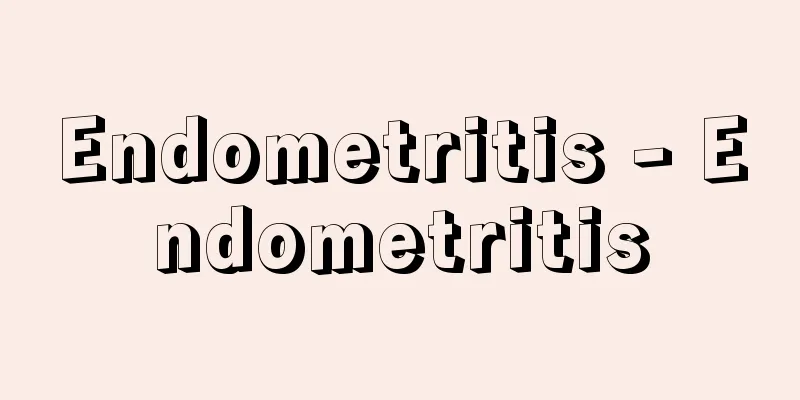Endometritis - Endometritis

What is the disease?Endometritis is an inflammation of the lining of the uterus. What is the cause?It is caused by inflammation due to bacterial infection. The majority of infections are caused by ascending infection, but in rare cases, lymphatic, hematogenous, and descending (from the abdominal cavity through the fallopian tubes) infections are also seen (Figure 5). Those that cause descending infection In women who menstruate regularly, the functional layer of the endometrium is periodically shed, so even if bacteria invade, they may be expelled during menstruation (Figure 6). How symptoms manifest Symptoms include lower abdominal discomfort, lower abdominal pain, and slight fever. Testing and diagnosis Pelvic examination reveals tenderness in the uterus. If the inflammation extends to the adnexa and pelvis, tenderness in the adnexal region and Douglas rectum may develop. Endometritis can be classified as acute or chronic. Acute endometritis occurs when the functional layer of the endometrium is infected and the functional layer is damaged during menstruation. Chronic endometritis occurs when the infection spreads to the basal layer of the endometrium, and the infection becomes chronic because the basal layer is not shed during menstruation. Bacteria remaining in the basal layer reinfect the regenerating functional layer, and the course becomes chronic. In tuberculous endometritis and senile endometritis, the condition progresses chronically. Treatment methodsIf the causative bacteria has been identified, antibiotics that are sensitive to that bacteria are used. Until the causative bacteria is identified, broad-spectrum antibiotics (those with a wide range of effects) are usually used. Anti-inflammatory drugs may also be used in combination. After a miscarriage or childbirth, uterotonic drugs may also be used in combination to encourage the expulsion of tissue remaining in the uterine cavity. If a uterine pyometra has formed, the cervix must be dilated and the pus must be expelled. What to do if you notice an illness Lower abdominal pain or abnormal Related TopicsMyometrial (parenchymal) inflammation Toru Takeuchi "> Figure 5. Infection route of endometritis "> Figure 6 Endometrium and myometrium Source: Houken “Sixth Edition Family Medicine Encyclopedia” Information about the Sixth Edition Family Medicine Encyclopedia |
どんな病気か子宮内膜炎とは、子宮内腔をおおっている子宮内膜の炎症のことです。 原因は何か細菌感染による炎症が原因になります。感染経路は、上行性感染によるものが大部分ですが、まれにリンパ行性、血行性、下行性(腹腔内から卵管を介して)感染も認められます(図5)。 下行性感染を起こすものでは 月経が定期的にある女性では、子宮内膜の機能層は周期的にはがれ落ちるので、細菌が侵入してきても月経時に排出されてしまうこともあります(図6)。閉経後や分娩後、流産後の女性では周期的な子宮内膜の 症状の現れ方 下腹部の不快感、下腹部痛、微熱などの症状が多いのですが、 検査と診断 内診により、子宮に圧痛が認められます。炎症がさらに付属器や骨盤内にまで拡大すると付属器領域やダグラス 子宮内膜炎は、急性と慢性とに分類できます。急性子宮内膜炎は、子宮内膜の機能層に感染が起こっているもので、月経時に機能層が 慢性子宮内膜炎は、感染が子宮内膜の基底層まで波及する場合で、月経時に基底層が排出されないため感染は慢性化します。基底層に残る細菌は、再生されてくる機能層で再度感染するため、経過は慢性化します。 結核性子宮内膜炎や老人性子宮内膜炎では慢性に経過します。老人性子宮内膜炎では、子宮 治療の方法起炎菌が特定されている場合には、その菌に感受性のある抗生剤を使用します。起炎菌が特定されるまでの間は、通常、広域スペクトル(効果の範囲が広い)の抗生剤を使用します。また、消炎薬を併用することもあります。流産後や分娩後では子宮収縮薬を併用することで子宮内腔に残った組織の排出を促すこともあります。子宮瘤膿腫を形成している場合には、頸管を開大し、うみを排出する必要があります。 病気に気づいたらどうする 下腹部痛や異常な 関連項目子宮筋層(実質)炎 竹内 亨 "> 図5 子宮内膜炎の感染経路 "> 図6 子宮内膜と子宮筋層 出典 法研「六訂版 家庭医学大全科」六訂版 家庭医学大全科について 情報 |
>>: Uterine erosion (English spelling)
Recommend
Myoko [village] - Myoko
A village in Nakakubiki County in southern Niigata...
Mount Myoko
It is the main peak of the Myoko volcanic group, ...
Hayashi phase
…When nuclear reactions finally begin in the cent...
apothecary
…However, in some cases, such as Paris, a profess...
Ontang Gorge
...A tributary of the Yangtze River in the easter...
Stratum (English)
It is a rather ambiguous concept, being used on t...
Plaid Cymru
...The movement, which had been in a slump due to...
On Ok - On Ok
In 583, the Western Turks became independent and ...
Tjipto Mangunkusumo
1885‐1943 An Indonesian doctor and nationalist lea...
Eviction - Oidashi
1. To expel. To banish. Kick-out "Graduates K...
Managed Prostitution
…The brothels were large, but the sake shops were...
Dobrudzha
…It is currently divided into Romanian and Bulgar...
Remembrance - Ejo
… However, at the age of 47, in April 87 (Bun'...
Animation (English)
A technique for giving lifelike movement to inanim...
Sound negative - Otonega
...A completely edited "all-rush" is ma...









